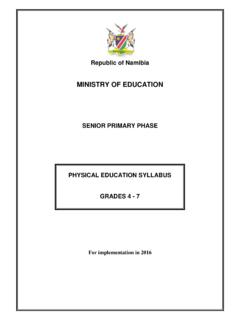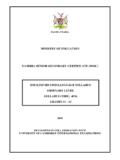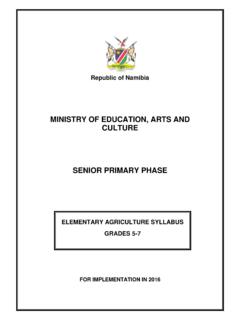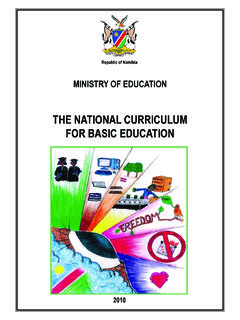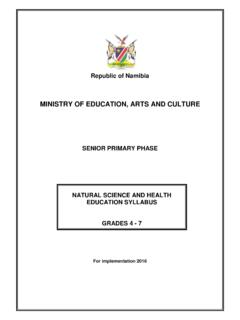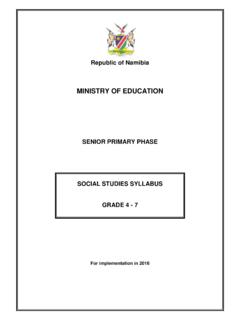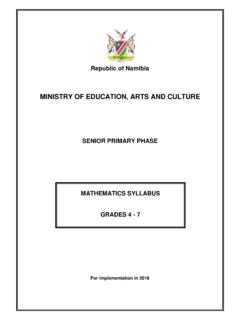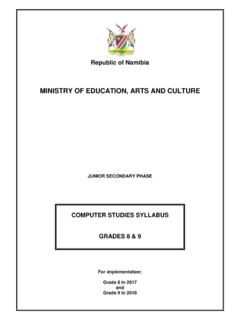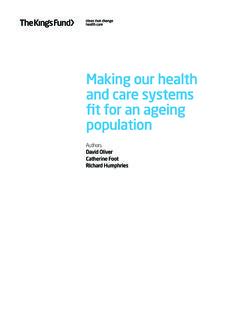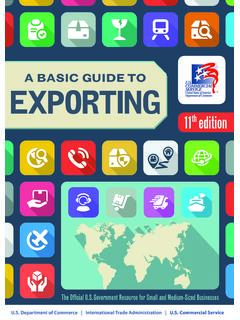Transcription of JUNIOR SECONDARY TEXTBOOK CATALOGUE Grades 8-9
1 REPUBLIC OF NAMIBIA MINISTRY OF EDUCATION, ARTS AND CULTURE 2016 JUNIOR SECONDARY TEXTBOOK CATALOGUE Grades 8-9 Revised Curriculum Ministry of Education, Arts & Culture National Institute for Educational Development (NIED) Private Bag 2034 Okahandja NAMIBIA Copyright NIED, Ministry of Education, Arts & Culture 2016 TEXTBOOK CATALOGUE for JUNIOR SECONDARY ( Grades 8-9) ISBN: 9789994521821 Printed by NIED Website: Publication date: July 2016 TABLE OF CONTENTS 1. 1 2. Minimum learning support materials profile .. 3 3. How should schools select their instructional materials?.. 5 The procedures .. 5 TEXTBOOK selection advice and criteria .. 5 Explanation of columns used in the TEXTBOOK CATALOGUE .. 6 4. Learner's books and teacher's guides .. 7 Languages .. 7 Content subjects .. 17 Pre-vocational subjects .. 20 Support subjects .. 23 Learning Support.
2 26 Annexe A: Publishers addresses and contact details .. 26 Annexe B: Publishers code of conduct .. 30 2016 JUNIOR SECONDARY ( Grades 8-9) TEXTBOOK CATALOGUE 1 1. INTRODUCTION The Ministry of Education, Arts and Culture thoroughly revised the curriculum for Pre-primary to Grade 12. A revised TEXTBOOK CATALOGUE format and procedures will go hand in hand with the implementation of the revised curriculum, which started in 2015 with the JP phase. Up to 2011 there was no limitation to the number of titles included in the TEXTBOOK CATALOGUE . However, since the evaluation of JUNIOR Primary learning support materials in April 2014 the number of titles are limited to the best three titles per subject per grade. This TEXTBOOK CATALOGUE for the JUNIOR SECONDARY (JS) phase ( Grades 8-9) gives the revised, comprehensive list of textbooks and other instructional materials for use in government schools in the following subjects: PROMOTIONAL CORE AND ELECTVIVE SUBJECTS: Languages PROMOTIONAL CORE SUBJECTS: Content Subjects PROMOTIONAL ELECTIVE SUBJECTS.
3 Academic and Pre-vocational streams SUPPORT SUBJECTS - Afrikaans First Language - Afrikaans Second Language - English First Language* - English Second Language (the Teacher's Guide must include a CD) - German First Language* - Khoekhoegowab First Language - Oshikwanyama First Language - Oshindonga First Language - Otjiherero First Language* - Rukwangali First Language* - Rumanyo First Language* - Setswana First Language - Silozi First Language* - Thimbukushu First Language* - History - Geography - Mathematics - Life Science - Physical Science - - Agricultural Science - Accounting - Computer Studies - Design and Technology - Entrepreneurship - Visual Art - Intergrated Performing Arts (IPA) - Office Practice - Fashion and Fabrics - Home Economics - Hospitality - Technical Studies (A, B or C, each with Technical Drawing)* - Life Skills - Religious and Moral Education (RME) - Information and Communication (IC) [Teacher's Guide only] - Physical Education (PE) - [Teacher's Guide only] * - Arts [Teacher's Guide only]* Non-curricular Reading Period - Any Readers, in all languages* The list of approved titles includes learner s books, teacher s guides and other instructional materials such as class readers.
4 Currently some subjects in this CATALOGUE have less than three titles. New titles for subjects indicated with an asterisk (*) above are not included in this CATALOGUE due to limited submissions and other factors. 2016 JUNIOR SECONDARY ( Grades 8-9) TEXTBOOK CATALOGUE 2 The Curriculum Panels for these subjects were instructed by the Ministry to select and recommend the best two titles from the previous TEXTBOOK CATALOGUE ( 2013 ). The recommended titles will be on this JUNIOR SECONDARY ( Grades 8-9) TEXTBOOK CATALOGUE for one year (2016) only while gap submissions are awaited. For Arts, a teacher s manual developed by the Finnish Art Project at NIED in cooperation with the Finnish Namibian Society will be used. An updated JUNIOR SECONDARY (JS) list of approved titles will be provided to schools after the evaluation of gap submissions in April 2017. Note that the evaluation and vetting of the materials was guided by the quality and relevance of the materials to the level of the learner.
5 Furthermore, the changes in the newly revised JUNIOR SECONDARY curriculum have been addressed. The curriculum will be reviewed every five years and the life span of a TEXTBOOK should be five years. The Ministry will continue to request submissions in order to achieve the desired three titles per subject to be used for a period of five years. It should be noted that books currently available in the schools should not be regarded as completely obsolete as they can still be used as resources. Schools are expected to select all their books from this JUNIOR SECONDARY TEXTBOOK CATALOGUE and ensure that they examine the relevant books before they decide on the books to be purchased, using the criteria and procedures laid down in the School TEXTBOOK Management Handbook ( 2013 ) produced by the Directorate: Programmes and Quality Assurance (PQA). It is important to note that schools should select only one series per subject.
6 The whole series, meaning the same title from Grade 8-9, should be used per subject. It is recommended that teachers/schools order one copy of the other approved titles for a subject listed in the CATALOGUE and use them for enrichment purposes and as a resource for teachers. The listing of the learner s books is done alphabetically according to subjects. The list of titles within each subject does not in any way suggest an order of preference or evaluation ranking. Each JUNIOR SECONDARY school in Namibia will be supplied with a free copy of the 2016 TEXTBOOK CATALOGUE through their respective REOs. A school can order any TEXTBOOK or other instructional materials that may be needed for any class and in any subject as long as these titles/items are contained in this 2016 TEXTBOOK CATALOGUE . The list will be revised regularly to include new instructional materials approved by the Ministry and to update prices. 2016 JUNIOR SECONDARY ( Grades 8-9) TEXTBOOK CATALOGUE 3 List of abbreviations Gr Grade GRN Government of Republic of Namibia ISBN International Standard Book Identification Number JP JS L LB JUNIOR Primary JUNIOR SECONDARY Literature texts Learner's Book LSM Learning Support Materials MoEAC Ministry of Education, Arts and Culture NPH Namibia Publishing House PQA R Programmes, Quality and Assurance Read REO Regional Education Office SM STSC Supplementary Materials School TEXTBOOK Selection Committee SP TG Senior Primary Teacher's Guide VAT Value Added Tax WB Workbook 2.
7 MINIMUM LEARNING SUPPORT MATERIALS PROFILE The Minimum Learning Support Materials profile is an agreed minimum list of learning support materials needed by learners and teachers in order for all learners to achieve the learning objectives of the curriculum. The minimum LSM profile is qualified with quantities ( 1 per learner; 5 per class; 1 per teacher; etc). The minimum LSM profile is specified by grade level and by subject. It must be affordable to Government, it must fit Namibia s educational approach and it must be sustainable. The minimum LSM profile that follows is based on the revised curriculum ( 2014 onwards), which is still a work in progress for some areas. It thus assumes a gradual introduction staged over a number of years and capable of taking into account changes initiated by future curriculum reviews. Teacher's guides for English Second Language should be supported by a CD containing pronunciation guidance to teachers as well as audio recordings of texts (paragraphs, poems, stories) included in the learner book.
8 2016 JUNIOR SECONDARY ( Grades 8-9) TEXTBOOK CATALOGUE 4 The JUNIOR SECONDARY (JS) minimum Learning Support Materials (LSM) profile: CORE PACK SUPPLEMENTARY MATERIALS Type Subject Learner Book Teachers Guide Other Learning Support Materials Type Ratio per teacher Promotional Core Subjects English First or Second lang. Literature1 1 3 titles (set of volumes per teacher)2 1 Dictionary Grammar book 15 per phase 15 per phase Mathematics 1 1 Wall charts 1 set per phase Another language (First, Second or Foreign) Literature1 (First & Second languages) 1 3 titles (set of volumes per teacher)2 1 Dictionary Grammar book Orthography3 Glossary3 15 per phase 15 per phase 5 5 Physical Science Life Science 2 (1 per subject per learner) 2 (1 per subject per teacher) Wall charts DVDs 1 set per phase 1 per phase Geography History 2 (1 per subject per learner) 2 (1 per subject per teacher) Wall charts Maps Atlases Globes DVDs 1 set per phase 1 set per phase 20 for JS + SS Promotional elective subjects 18 Languages, Agricultural Sc.
9 , Design & Tech., Accounting, Entrepreneurship, Computer Studies, Office Practice, Home Economics, Fashion & Fabrics, Visual Art, Integrated Performing Arts, Tech St. A, B or C, Tech Drawing, Hospitality 2 (1 per subject per learner, including 3 literature titles for languages) 2 (1 per subject per teacher) Atlas with soil and climate zones, Globe Wall charts Music CDs Movie DVDs Arts Wall charts Full class set 10 per phase Compulsory support subjects Life Skills RME Phys. Education Information & Com. Arts 1 1 - 1 - 1 1 1 1 1 Wall Charts CDs DVDs Non-curricular Reading Period Reading period 1 Readers, all languages 50 titles, various languages 1 In SECONDARY Grades separate anthologies are preferred for poems, short stories or one act plays 2 The ideal situation is that every learner should have a book, but a teacher could also have a full class set which is used by all class groups to which a teacher teaches 3 Orthographies and glossaries are for African languages only 2016 JUNIOR SECONDARY ( Grades 8-9) TEXTBOOK CATALOGUE 5 3.
10 HOW SHOULD SCHOOLS SELECT THEIR INSTRUCTIONAL MATERIALS? The School TEXTBOOK Management Handbook gives detailed step by step advice on how schools should select their instructional materials. Nevertheless, here is a summary of the the steps to be taken and the traps to avoid: The Procedures The school should set up a School TEXTBOOK Selection Committee (STSC) and list the members of the committee in the Minute Book. Subject teachers should be involved in selecting the books. The STSC should first make a list of the textbooks, teachers guides and other instructional materials that are already in the school so that the most urgent priorities for new books can be decided. The committee should study the present JUNIOR SECONDARY TEXTBOOK CATALOGUE to determine which books and other instructional materials to purchase. It should be noted that no books/items outside the approved list issued by NIED can be purchased using funds given to schools.

